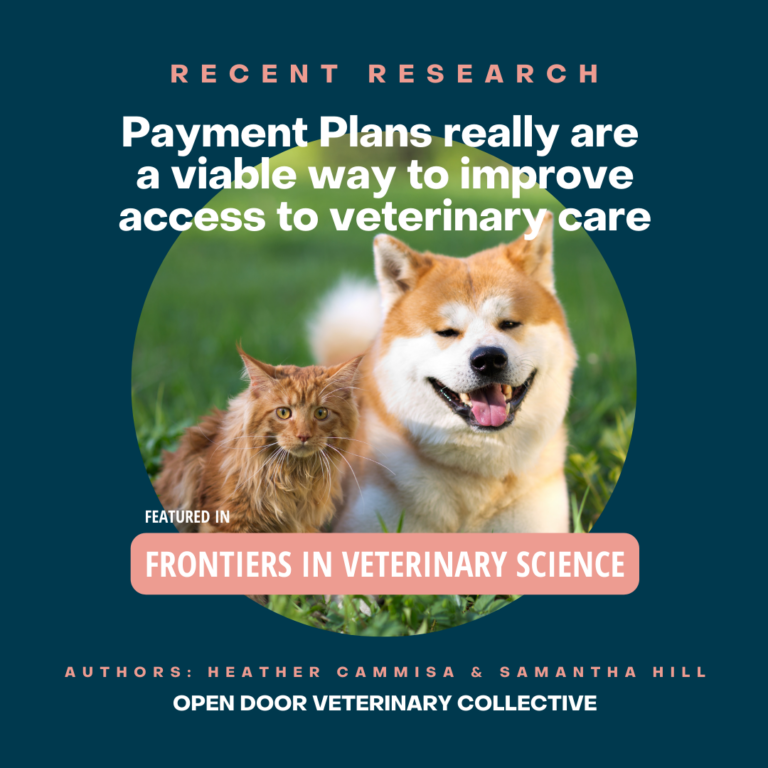Access to affordable and timely veterinary care for our beloved pets has long been a concern for both pet owners and veterinary professionals. A recent groundbreaking study has now shed light on an innovative solution to this pressing issue – the use of in-house payment plans.
Modernizing Outdated Payment Plan Practices
Payment plans have long been a strategy for addressing client financial constraints, but when self-managed by veterinary clinics, client payment compliance was poor and most hospitals lacked the skills and staffing to efficiently manage them. Clinics typically rely on informal strategies like holding post-dated checks or client credit card accounts; using promissory notes or verbal agreements; or sending periodic invoices to clients. These methods generally yield poor results for the clinic.
Open Door Veterinary Collective, a nonprofit organization dedicated to teaching and mentoring veterinary clinics to sustainably improve access to care, wanted to find out whether outsourcing in-house payments to a third-party payment management provider, which provides a structured system for managing and collecting client payments, produced better results for clinics and clients alike.
Analyzing Six Years of Veterinary Payment Plans: Insights from VetBilling
VetBilling supplied Open Door’s research team, led by Heather Cammisa and Samantha Hill, with access to 6 years of payment plan accounts. They examined VetBilling’s dataset of payment plans, which bypass traditional credit scoring and empower clinics to determine approvals based on their own internal criteria. The dataset included 397 unique veterinary clinics of various types, including small animal, mixed animal, emergency, and nonprofit. A total of 21,225 individual client accounts were reviewed.
Cammisa and Hill’s independent analysis showed that when VetBilling’s built-in soft credit check feature was used to optimally structure payment contracts, 95.1% of accounts were successfully repaid. When the soft credit check feature was not used (it is optional for clinics), payment compliance dropped marginally to 93.8%. These numbers compare very favorably to repayment rates anecdotally reported by clinics that self-manage client payments.
This analysis offers new insights into how to mitigate cash flow and credit ineligibility challenges for veterinary clients, significantly reducing cost barriers to care.
VetBilling did not compensate Open Door in any way, and had no input on the data analysis or conclusions.
A Fresh Perspective on Veterinary Care
At the core of this research is the revelation of the financial fragility often experienced by pet-owning families. The study uncovers the cash flow crisis that frequently stands in the way of accessing essential veterinary care. More significantly, it explores the potential of payment options to act as bridges, connecting veterinarians and clients in their quest for comprehensive pet care. This, in turn, introduces a groundbreaking concept known as the “veterinary care multiplier.”
The veterinary care multiplier assesses the untapped potential of providing more extensive care through for-profit and non-profit clinics when additional payment options are introduced. It’s a game-changing approach that has the potential to transform the way veterinary care is offered to clients.
Unlocking New Possibilities
The research suggests that non-profit clinics could increase their veterinary care offerings exponentially by allocating donor funds to cover the approximately 6.9% of potentially unpaid balances, as opposed to always offering full subsidies.
Similarly, for-profit clinics could take a leap forward by reallocating their discount budget to cater to clients who are typically turned away by traditional credit options. This strategy not only enhances the accessibility of care, it has profound implications for those pet owners who, due to financial constraints, have had to make heart-wrenching decisions to forgo essential treatments, surrender their animal, or face economic euthanasia.
The Road Ahead
While this research is undoubtedly a significant step toward solving the veterinary care access issue, the journey is far from complete. Further research is needed to dive deeper into the impact of these payment options on all financially fragile pet owners and the outcomes for clients who are declined by traditional credit methods.
Understanding how payment options can reduce the painful choice of economic euthanasia decisions, reduce stress for both clients and veterinary staff, increase the perception of value and compliance with suggested care, and boost clinic revenue is essential.
Conclusion: A Brighter Future for Pet Health
In conclusion, this research offers a glimmer of hope for both pet owners and veterinarians. By introducing payment options that aren’t dependent on traditional credit scoring, it presents a viable solution to the financial barriers that often hinder access to essential veterinary care. This is a stride toward a brighter future where every pet, regardless of their owner’s financial situation, can receive the care they need and deserve.
About the Researchers:
Heather Cammisa and Samantha Hill of Open Door Veterinary Collective spearheaded this research effort, dedicated to improving access to veterinary care. Open Door Veterinary Collective gratefully acknowledges a grant from Life of Riley at Spring Point Partners that funded this important research.
About the Journal:
This research was published in Frontiers in Veterinary Science and can be accessed here: Payment options: An analysis of 6 years of payment plan data and potential implications for for-profit clinics, non-profit veterinary providers, and funders to access to care initiatives
